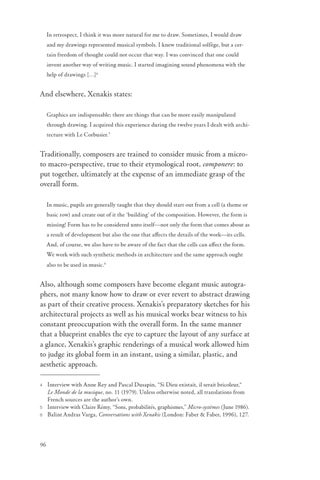In retrospect, I think it was more natural for me to draw. Sometimes, I would draw and my drawings represented musical symbols. I knew traditional solfège, but a certain freedom of thought could not occur that way. I was convinced that one could invent another way of writing music. I started imagining sound phenomena with the help of drawings […]4
And elsewhere, Xenakis states: Graphics are indispensable; there are things that can be more easily manipulated through drawing. I acquired this experience during the twelve years I dealt with architecture with Le Corbusier.5
Traditionally, composers are trained to consider music from a microto macro-perspective, true to their etymological root, componere: to put together, ultimately at the expense of an immediate grasp of the overall form. In music, pupils are generally taught that they should start out from a cell (a theme or basic row) and create out of it the ‘building’ of the composition. However, the form is missing! Form has to be considered unto itself—not only the form that comes about as a result of development but also the one that affects the details of the work—its cells. And, of course, we also have to be aware of the fact that the cells can affect the form. We work with such synthetic methods in architecture and the same approach ought also to be used in music.6
Also, although some composers have become elegant music autographers, not many know how to draw or ever revert to abstract drawing as part of their creative process. Xenakis’s preparatory sketches for his architectural projects as well as his musical works bear witness to his constant preoccupation with the overall form. In the same manner that a blueprint enables the eye to capture the layout of any surface at a glance, Xenakis’s graphic renderings of a musical work allowed him to judge its global form in an instant, using a similar, plastic, and aesthetic approach. 4�
5� 6�
96
Interview with Anne Rey and Pascal Dusapin, “Si Dieu existait, il serait bricoleur,“ Le Monde de la musique, no. 11 (1979). Unless otherwise noted, all translations from French sources are the author’s own. Interview with Claire Rémy, “Sons, probabilités, graphismes,” Micro-systèmes (June 1986). Balint Andras Varga, Conversations with Xenakis (London: Faber & Faber, 1996), 127.
